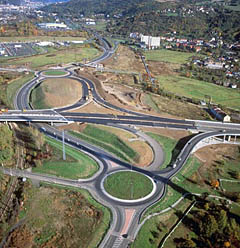
The Chamber supported the amendment allowing combined proceedings for buildings
 |
The so-called coordinated permitting procedure should merge the currently separated territorial procedure, building procedure, and environmental impact assessment (EIA). According to the ministry, this is expected to significantly speed up the approval of constructions. Such a construction will be permitted and located with one administrative decision. However, the merged procedure will not be mandatory; the investor will be able to choose whether to use it or to proceed according to the existing legal regulations. The inclusion of the EIA process into the procedures under the law is intended to eliminate duplications of individual steps and thus speed up the preparation and implementation of constructions.
The merging of building procedures will be possible primarily for constructions of railways, roads, highways, local communications, or water works, as well as for constructions related to radioactive waste repositories, oil pipelines, product pipelines, electrical transmission networks, or power plants with an installed capacity of 100 megawatts or higher. The authority that will be able to approve the merged procedure will be the authority responsible for the approval of the construction, such as the ministry, regional authorities, municipal authorities of municipalities with extended powers, or designated municipal authorities. For transport constructions and water works, it will be specialized building authorities. For some constructions related to energy, it will be the Ministry of Industry.
In light of the proposed merged procedure, the bill also newly defines a set of constructions and distinguishes between main and auxiliary constructions. This will help resolve situations where components of constructions may fall under the jurisdiction of different building authorities. The determination of the main construction is then crucial for identifying the appropriate authority to conduct the joint procedure. The main construction in the set of constructions will be the one that determines the purpose of the entire set of constructions.
The Ministry for Regional Development expects that the amendment will also ease the burden on small builders. For instance, it will allow self-help construction for all types of family houses without specifying the built-up area. On the property of a family house or a house intended for recreation, anyone will be able to build a pool or a greenhouse solely based on their location without subsequent permitting.
All urban planning documents will be mandatory published on the internet, allowing the public better oversight over the entire process.
The proposal also includes the authorization for Prague to issue its own building regulations, contrary to the proposal from the Ministry of Regional Development.
However, some deputies expressed doubts about the bill. For example, Jiří Petrů (ČSSD) stated that the proposal does not simplify the requirements for builders. He recommended that the government begin working on a complete recodification of building regulations aimed at simplifying processes. Jan Klán (KSČM) quoted from the statement of an unnamed building authority, which claims that the amendment will not bring acceleration and simplification of processes.
The English translation is powered by AI tool. Switch to Czech to view the original text source.
0 comments
add comment
Related articles
0
01.04.2015 | Today, the amendment to the EIA law comes into effect, and builders are criticizing it
0
11.02.2015 | Parliament limited the misuse of construction delays by lawsuits in the EIA process
0
13.12.2014 | Ecologists welcome the amendment on EIA, while builders and entrepreneurs are not pleased
0
11.11.2014 | The committee recommended approving the amendment to the EIA with adjustments
0
04.06.2014 | The builders do not like the changes related to EIA, claiming that it will stop construction projects





